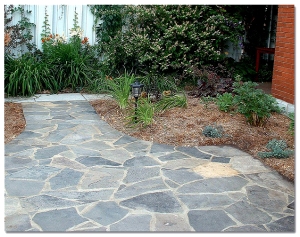Building an addition onto your home requires a significant investment of time, patience and money. Savvy homeowners who simply want more living space opt for transforming an outside area instead. The cost comes in considerably lower, and the amount of patience and time required depends on whether you go the DIY route or ask your professional handyman for help. One of the first decisions you must make about a new patio involves the surface itself. Several options exist, whether you have dirt and weeds to start with or an already-poured concrete surface. Let’s take a look at the available materials:
Concrete
If your home already has a concrete slab in the patio area, you can dress up the design by stamping it to resemble pavers. A simple design will involve one color, while an intermediate may involve multiple colors and perhaps a contrasting border. An advanced design may include borders, saw-cut designs and hand-applied chemical stain accents. As you can imagine, when the design increases in complexity, so does the cost. You also can opt to install a concrete slab where none existed before, but you will need to wait the appropriate amount of time for it to fully form before starting a stamping project; this typically takes 28 days.
You also can have a boring concrete slab removed, or start from scratch, and then install actual concrete pavers in the patio area. Pavers come in a variety of shapes and colors, allowing you to create a look that complements the architecture of your home.
In general, concrete pavers last longer than a poured slab, as they stand up to weather better and require little maintenance. You can easily replace one cracked paver out of hundreds that make up the patio surface, but a cracked slab needs to be broken up and repoured.
Another inexpensive option when it comes to concrete involves creating pavers using a form. You simply place the form, then pour the concrete into the form and smooth over. After five minutes, you pull up the form and replace in an adjacent area. You can even color the concrete during the mixing process to customize the look. Forms come in several shapes, including brick and cobblestone, and multiple patterns.
Brick
Brick pavers have many of the benefits of concrete pavers but come in a more limited number of shapes and colors, mostly shades of red, brown and gray because the clay used determines the color. You can create design patterns from simple to complex for your patio area, just as you can with concrete pavers. Maintenance proves similar to that of concrete pavers, as well.
Photo Credit: Merlene on Flickr
Stone
Unlike concrete and brick, stone pavers already exist in nature. Bluestone, limestone and flagstone are among the many options if you want to create an outdoor living space that has old-world charm. Typically a square or rectangular shape, they can be placed in a variety of patterns, including herringbone, basket weave and running bond, as well as and ashlar, which involves using different sizes of stone pavers. They also prove resilient to weather conditions and require little maintenance.
as and ashlar, which involves using different sizes of stone pavers. They also prove resilient to weather conditions and require little maintenance.
Wood
Wood doesn’t just suit decks, it also works well for patios in certain areas of the country. Check out this recent post about building a deck for not only design ideas but also for information about building codes and costs.
When deciding which material to use and in what design, your handyman can provide his expert opinion about what works — and looks — best in your area of the country.
This article is part of the Deck Repair and Maintenance Series
Mr. Handyman can maintain your home to save you money. One call really does take care of everything on your to-do list. All Mr. Handyman franchises are Fully Insured. Make sure to stay on top of all your household repairs, improvements and maintenance needs and request service in your area.



























